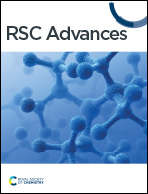Assessment of metabolome diversity in black and white pepper in response to autoclaving using MS- and NMR-based metabolomics and in relation to its remote and direct antimicrobial effects against food-borne pathogens†
Abstract
Piper nigrum L. (black and white peppercorn) is one of the most common culinary spices used worldwide. The current study aims to dissect pepper metabolome using 1H-NMR targeting of its major primary and secondary metabolites. Eighteen metabolites were identified with piperine detected in black and white pepper at 20.2 and 23.9 μg mg−1, respectively. Aroma profiling using HS-SPME coupled to GC-MS analysis and in the context of autoclave treatment led to the detection of a total of 52 volatiles with an abundance of β-caryophyllene at 82% and 59% in black and white pepper, respectively. Autoclaving of black and white pepper revealed improvement of pepper aroma as manifested by an increase in oxygenated compounds' level. In vitro remote antimicrobial activity against food-borne Gram-positive and Gram-negative bacteria revealed the highest activity against P. aeruginosa (VP-MIC 16.4 and 12.9 mg mL−1) and a direct effect against Enterobacter cloacae at ca. 11.6 mg mL−1 for both white and black pepper.



 Please wait while we load your content...
Please wait while we load your content...